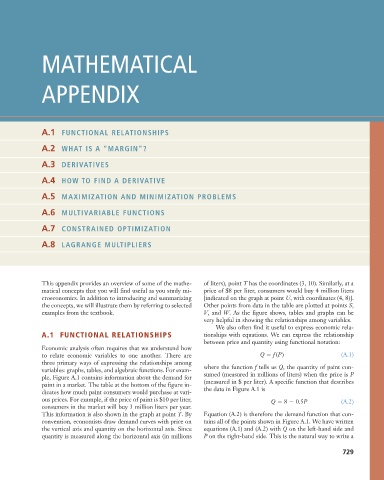Page 755 - Microeconomics, Fourth Edition
P. 755
BMappAMathematicalAppendix.qxd 8/17/10 1:10 AM Page 729
MATHEMATICAL
APPENDIX
A.1 FUNCTIONAL RELATIONSHIPS
A.2 WHAT IS A “MARGIN”?
A.3 DERIVATIVES
A.4 HOW TO FIND A DERIVATIVE
A.5 MAXIMIZATION AND MINIMIZATION PROBLEMS
A.6 MULTIVARIABLE FUNCTIONS
A.7 CONSTRAINED OPTIMIZATION
A.8 LAGRANGE MULTIPLIERS
This appendix provides an overview of some of the mathe- of liters), point T has the coordinates (3, 10). Similarly, at a
matical concepts that you will find useful as you study mi- price of $8 per liter, consumers would buy 4 million liters
croeconomics. In addition to introducing and summarizing [indicated on the graph at point U, with coordinates (4, 8)].
the concepts, we will illustrate them by referring to selected Other points from data in the table are plotted at points S,
examples from the textbook. V, and W. As the figure shows, tables and graphs can be
very helpful in showing the relationships among variables.
We also often find it useful to express economic rela-
A.1 FUNCTIONAL RELATIONSHIPS tionships with equations. We can express the relationship
between price and quantity using functional notation:
Economic analysis often requires that we understand how
to relate economic variables to one another. There are Q f (P ) (A.1)
three primary ways of expressing the relationships among
variables: graphs, tables, and algebraic functions. For exam- where the function f tells us Q, the quantity of paint con-
ple, Figure A.1 contains information about the demand for sumed (measured in millions of liters) when the price is P
paint in a market. The table at the bottom of the figure in- (measured in $ per liter). A specific function that describes
dicates how much paint consumers would purchase at vari- the data in Figure A.1 is
ous prices. For example, if the price of paint is $10 per liter, Q 8 0.5P (A.2)
consumers in the market will buy 3 million liters per year.
This information is also shown in the graph at point T. By Equation (A.2) is therefore the demand function that con-
convention, economists draw demand curves with price on tains all of the points shown in Figure A.1. We have written
the vertical axis and quantity on the horizontal axis. Since equations (A.1) and (A.2) with Q on the left-hand side and
quantity is measured along the horizontal axis (in millions P on the right-hand side. This is the natural way to write a
729

